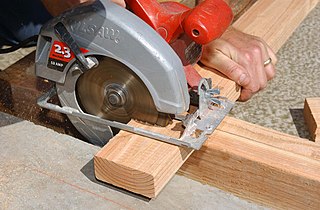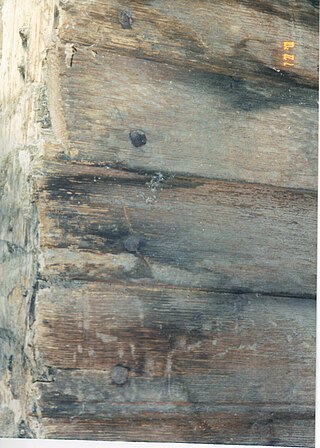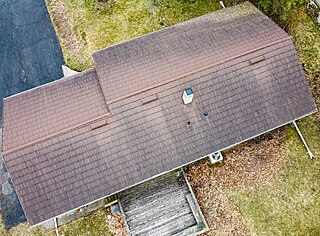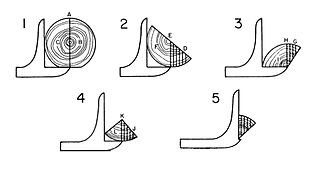
Flat sawing, flitch sawing or plain sawing is a woodworking process that produces flat-cut or plain-cut boards of lumber. [1]

Flat sawing, flitch sawing or plain sawing is a woodworking process that produces flat-cut or plain-cut boards of lumber. [1]
After an initial cut through the diameter of a log, parallel cuts produce flitches: strips of lumber with consistent thickness. [2] Two cuts on each flitch trim the bark from the sides, and reduces it to a standard board width with squared edges. Two more cuts at each end set the length.
Lumber can be quickly flat-cut with a side-by-side set of mechanical saws. [3] A slower but sturdier method involves passing the log back and forth over a single saw.
To reduce buckling that may occur along the middle of flat-cut boards, the initial cut may be offset from the diameter, and resulting sections cut further before cutting the flitches.
Flat-sawn wood often exhibits "flat-" or "slash grain", where the angle between the visible growth rings and the width of the board is 45° or less. [4] This makes the wood vulnerable to deformation as it dries, or if later exposed to moisture. Flat-sawn wood is less stable than quarter sawn or rift sawn wood, but can be produced more quickly and at lower cost. [5]
The face of the board may show curved grain, sometimes with intricate patterns.

Lumber is wood that has been processed into uniform and useful sizes, including beams and planks or boards. Lumber is mainly used for construction framing, as well as finishing. Lumber has many uses beyond home building. Lumber is referred to as timber in the United Kingdom, Europe, Australia, and New Zealand, while in other parts of the world the term timber refers specifically to unprocessed wood fiber, such as cut logs or standing trees that have yet to be cut.

Plywood is a composite material manufactured from thin layers, or "plies", of wood veneer that have been stacked and glued together. It is an engineered wood from the family of manufactured boards, which include plywood, medium-density fibreboard (MDF), oriented strand board (OSB), and particle board.

A circular saw or a buzz saw, is a power-saw using a toothed or abrasive disc or blade to cut different materials using a rotary motion spinning around an arbor. A hole saw and ring saw also use a rotary motion but are different from a circular saw. Circular saws may also be loosely used for the blade itself. Circular saws were invented in the late 18th century and were in common use in sawmills in the United States by the middle of the 19th century.

Joinery is a part of woodworking that involves joining pieces of wood, engineered lumber, or synthetic substitutes, to produce more complex items. Some woodworking joints employ mechanical fasteners, bindings, or adhesives, while others use only wood elements.
A saw is a tool consisting of a tough blade, wire, or chain with a hard toothed edge used to cut through material. Various terms are used to describe toothed and abrasive saws.

In woodworking, a rip-cut is a type of cut that severs or divides a piece of wood parallel to the grain. The other typical type of cut is a cross-cut, a cut perpendicular to the grain. Unlike cross-cutting, which shears the wood fibers, a rip saw works more like a series of chisels, lifting off small splinters of wood. The nature of the wood grain requires the shape of the saw teeth to be different, thus the need for both rip saws and crosscut saws; however, some circular saw blades are combination blades and can make both types of cuts. A rip cut is the fundamental type of cut made at a sawmill.

A sawmill or lumber mill is a facility where logs are cut into lumber. Modern sawmills use a motorized saw to cut logs lengthwise to make long pieces, and crosswise to length depending on standard or custom sizes. The "portable" sawmill is simple to operate. The log lies flat on a steel bed, and the motorized saw cuts the log horizontally along the length of the bed, by the operator manually pushing the saw. The most basic kind of sawmill consists of a chainsaw and a customized jig, with similar horizontal operation.

A hand plane is a tool for shaping wood using muscle power to force the cutting blade over the wood surface. Some rotary power planers are motorized power tools used for the same types of larger tasks, but are unsuitable for fine-scale planing, where a miniature hand plane is used.

A log house, or log building, is a structure built with horizontal logs interlocked at the corners by notching. Logs may be round, squared or hewn to other shapes, either handcrafted or milled. The term "log cabin" generally refers to a smaller, more rustic log house, such as a hunting cabin in the woods, that may or may not have electricity or plumbing.

A miter saw or mitre saw is a saw used to make accurate crosscuts and miters in a workpiece by positioning a mounted blade onto a board. A miter saw in its earliest form was composed of a back saw in a miter box, but in modern implementation consists of a powered circular saw that can be positioned at a variety of angles and lowered onto a board positioned against a backstop called the fence.

Clapboard, also called bevel siding, lap siding, and weatherboard, with regional variation in the definition of those terms, is wooden siding of a building in the form of horizontal boards, often overlapping.

Wood shingles are thin, tapered pieces of wood primarily used to cover roofs and walls of buildings to protect them from the weather. Historically shingles, also known as shakes, were split from straight grained, knot free bolts of wood. Today shingles are mostly made by being cut which distinguishes them from shakes, which are made by being split out of a bolt.

Wood grain is the longitudinal arrangement of wood fibers or the pattern resulting from such an arrangement. It has various derived terms refer to different aspects of the fibers or patterns. Wood grain is important in woodworking and it impacts aesthetics.

In woodworking, veneer refers to thin slices of wood and sometimes bark that typically are glued onto core panels to produce flat panels such as doors, tops and panels for cabinets, parquet floors and parts of furniture. They are also used in marquetry. Plywood consists of three or more layers of veneer. Normally, each is glued with its grain at right angles to adjacent layers for strength. Veneer beading is a thin layer of decorative edging placed around objects, such as jewelry boxes. Veneer is also used to replace decorative papers in wood veneer high pressure laminate.

Quarter sawing or quartersawing is a woodworking process that produces quarter-sawn or quarter-cut boards in the rip cutting of logs into lumber. The resulting lumber can also be called radially-sawn or simply quartered. There is widespread confusion between the terms rift sawn and quarter sawn with the terms defined both with opposite meanings and as synonyms.
This glossary of woodworking lists a number of specialized terms and concepts used in woodworking, carpentry, and related disciplines.

Graf Brothers Flooring and Lumber specializes in, and is the world's largest manufacturer of, rift and quarter sawn oak products. Rift & Quartered lumber results from a unique way of sawing that maximizes the yield of lumber with vertical grain. Vertical grain is preferred because of its excellent technical properties. Lumber that has been sawed using this method expands evenly and vertically. Vertical grain also increases the structural integrity of the wood.
Rift sawing is a woodworking process that aims to produce lumber that is less vulnerable to distortion than flat-sawn lumber. Rift-sawing may be done strictly along a log's radials—perpendicular to the annular growth ring orientation or wood grain—or as part of the quarter sawing process.

Wood splitting is an ancient technique used in carpentry to make lumber for making wooden objects, some basket weaving, and to make firewood. Unlike wood sawing, the wood is split along the grain using tools such as a hammer and wedges, splitting maul, cleaving axe, side knife, or froe.
A swingblade sawmill utilizes a single circular sawblade which pivots about a 90 degree point, to saw in both vertical and horizontal planes. The single blade travels horizontally in one direction down the log, and returns in vertical position, thus removing a sawn piece of timber. The swingblade head unit is normally mounted on a moving frame that travels along a track or tracks, up and down a stationary log.